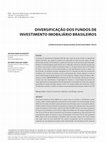Papers by Arthur Vieira de Moraes

Este é um artigo de acesso aberto, licenciado por Creative Commons Atribuição 4.0 Internacional (... more Este é um artigo de acesso aberto, licenciado por Creative Commons Atribuição 4.0 Internacional (CC BY 4.0), sendo permitidas reprodução, adaptação e distribuição desde que o autor e a fonte originais sejam creditados. RESUMO Os Fundos de Investimento Imobiliário (FII) são uma classe de ativos recente no mercado de capitais brasileiro, que, apesar de poderem ser negociados na bolsa tal como ações, são bem distintos das mesmas. Os investidores e acadêmicos deveriam se inteirar dessas particularidades. No Brasil, a academia apenas recentemente tem se dedicado a estudá-los. Uma das questões que se coloca, e que norteia o objetivo do presente estudo, é a de quais fatores levam os FII listados em bolsa a serem mais ou menos diversificados, ou seja, apresentarem menor ou maior risco diversificável. As hipóteses testadas consideram que (i) o tamanho do fundo de investimento imobiliário, (ii) o número de imóveis ou (iii) a concentração dos imóveis explicam a maior ou menor diversificação do fundo. Estudou-se 22 FII multiativos listados na Bolsa de Valores, Mer-cadorias e Futuros (BM&FBOVESPA) em dezembro de 2015. Os resultados indicam que os fundos maiores são mais diversificados. A quantidade de imóveis e a concentração dos imóveis não foram significantes na explicação da diversificação dos FII. As limitações do estudo são a pequena quantidade de fundos analisados (apenas 24 dos 127 fundos listados são multiativos, 2 deles considerados outliers) e a análise em apenas um período (devido ao pequeno histórico dos FII). Palavras-chave: fundo de investimento imobiliário, diversificação, tamanho. ABSTRACT Real Estate Investment Trusts (REITs) are a recent class of securities in the Brazilian capital markets, which, notwithstanding the fact that they can be traded in the stock exchange, are very different from stocks. Academics and practitioners should become aware of such particularities. In Brazil research has been devoted to study them just recently. One question that arises, and that guides the objective of this study, is what factors lead the REITs listed on the stock exchange to be more or less diversified, or, have lower or higher diversifiable risk. The research hypotheses are that (i) size of the real estate investment trust, (ii) number of properties or (iii) concentration of the properties explain the greater or lesser diversification of the fund. The 22 multi-properties REITs listed on the stock exchange in December 2015 have been studied. The results indicate that larger funds are more diversified. The number of properties and the concentration of properties are not significant to explain funds' diversification. The limitations of this study are





Uploads
Papers by Arthur Vieira de Moraes